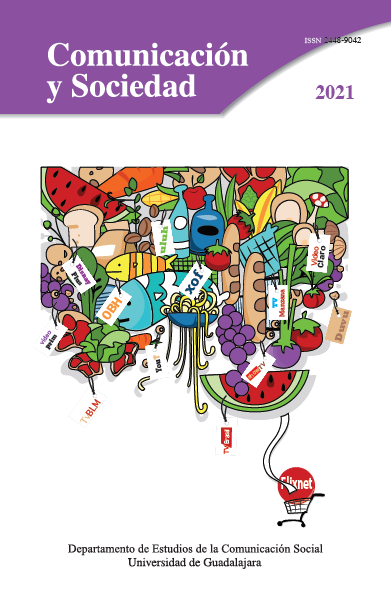Historia de las teen series en España: evolución y características
DOI:
https://doi.org/10.32870/cys.v2021.7979Palabras clave:
Ficción española, Televisión, Teen series, Personajes jóvenesResumen
Este artículo explora la evolución de las teen series españolas, emitidas por las televisiones generalistas y las plataformas VOD desde su debut en 1997 hasta 2020, mediante el análisis diacrónico de las 24 producciones protagonizadas por adolescentes. El estudio revela la configuración de un subgénero propio del drama televisivo y la preocupación por abordar los temas que interesan a la audiencia juvenil. Se evidencia una progresiva disociación entre el amor romántico y el sexo, así como una menor dependencia del núcleo familiar y un incremento de la conflictividad generacional.Descargas
Citas
Aubrey, J. S. (2004). Sex and Punishment: An Examination of Sexual Consequences and the Sexual Double Standard in Teen Programming. Sex Roles, 50(7/8), 505-514. https://doi.org/10.1023/B:SERS.0000023070.87195.07
Aubrun, A. & Grady, J. (2000). Aliens in the Living Room: How TV Shapes Our Understanding of ‘Teens’. The Frameworks Institute.
Banks, M. J. (2004). A Boy for All Planets: Roswell, Smallville and the Teen Male Melodrama. En G. Davis & K. Dickinson (Eds.), Teen TV. Genre, Consumption and Identity (pp. 17-28). BFI.
Bardají, H. & Gómez Amigo, S. (2004). La gestión de la creatividad en televisión. El caso de Globo Media. Eunsa.
Berridge, S. (2010). Serialised sexual violence in teen television drama series [Disertación doctoral inédita]. University of Glasgow. http://theses.gla.ac.uk/2326/
Berridge, S. (2011). Personal problems and women’s issues. Feminist Media Studies, 11(4), 467-481. http://dx.doi.org/10.1080/14680777.2011.555967
Berridge, S. (2013). Teen heroine TV: narrative complexity and sexual violence in female-fronted teen drama series. New Review of Film and Television Studies, 11(4), 477-496. https://doi.org/10.1080/17400309.2013.809565
Bindig, L. (2008). Dawson’s Creek. A Critical Understanding. Lexington Books.
Cascajosa, C. C. & Herrero, B. (2009). De “Compañeros” a “No te fallaré”: Manuel Ríos San Martín y la experiencia en la producción cinematográfica de Globomedia. En J. Marzal & F. J. Gómez (Eds.), El productor y la producción en la industria cinematográfica (pp. 495-506). Universidad Complutense de Madrid.
Chapoton, B., Werlen, A.-L. & Regnier Denois, V. (2019). Alcohol in TV series popular with teens: a content analysis of TV series in France 22 years after a restrictive law. The European Journal of Public Health, 30(2), 363-368. https://doi.org/10.1093/eurpub/ckz163
Chicharro-Merayo, M. M. (2012). Representaciones juveniles en la ficción televisiva. Los jóvenes, los adultos y la escuela en Física o Química. Doxa Comunicación, 14, 199-220. https://www.doxacomunicacion.es/es/hemeroteca/articulos?id=150
Davis, G. & Dickinson, K. (2004a). Introduction. En G. Davis & K. Dickinson (Eds.), Teen TV. Genre, Consumption and Identity (pp. 1-16). BFI.
Davis, G. & Dickinson, K. (2004b). Teen TV. Genre, Consumption and Identity. BFI.
Dhaenens, F. (2013). Teenage queerness: Negotiating heteronormativity in the representation of gay teenagers in Glee. Journal of Youth Studies, 16(3), 304-317. https://doi.org/10.1080/13676261.2012.718435
Driscoll, C. (2011). Teen Film: A Critical Introduction. Berg.
Fedele, M., Masanet, M. J. & Ventura, R. (2019). Negotiating love and gender stereotypes: Prevalence of “amor ludens” and television preferences rooted in hegemonic masculinity. Masculinities and Social Change, 8(1), 1-43. http://dx.doi.org/10.17583/mcs.2018.2749
Gajanan, M. (2020, 16 de julio). These Are the Most Popular Netflix Shows and Movies- According to Netflix. TIME. https://time.com/5697802/most-popular-shows-movies-netflix/
García Manso, A. (2013). Series de ficción y homosexualidad en España: Un intento por visibilizar la diversidad sexual. Revista Iberoamericana de Salud y Ciudadanía, 2(1), 29-55. https://security.ufpb.br/iohc/contents/documentos/books/sexuality-ies-and-citizenship-s
Guarinos, V. (2009). Fenómenos televisivos «teenagers»: prototipias adolescentes en series vistas en España. Comunicar, 17(33), 203-211. https://doi.org/10.3916/c33-2009-03-012
Heintz-Knowles, K. E. (2000). Images of Youth: A Content Analysis of Adolescents in Prime-Time Entertainment Programming. The Frameworks Institute.
Herrero, M. & Diego, P. (2009). Do Family Television Series Travel Well? A Spanish Case: Médico de Familia. Journal of Spanish Language Media, 2, 142-152. https://hdl.handle.net/10171/21279
Jenner, M. (2011). “I Can’t Even Imagine What It’s Gonna Be Like Here without Him”. Friendship and Queer Theory in American Teen Soap. In-Spire Journal of Law, Politics and Societies, 6(1), 30-48. https://inspirejournal.files.wordpress.com/2011/11/jenner61.pdf
Kjeldgaard, D. & Nielsen, K. S. (2010). Glocal gender identities in market places of transition: MARIANISMO and the consumption of the telenovela Rebelde. Marketing Theory, 10(1), 29-44. https://doi.org/10.1177/1470593109355249
Lacalle, C. (2013a). Jóvenes y ficción televisiva: Construcción de identidad y transmedialidad. Editorial UOC.
Lacalle, C. (2013b). La ficción resiste la crisis. En I. Vasallo & G. Orozco (Eds.), Anuario Obitel 2013. Memoria social y ficción televisiva en países iberoamericanos (pp. 279- 310). Sulina.
Lacalle, C. (2018). Memoria histórica y democracia: la ficción en el período socialista”. En J. Montero (Dir.), Una televisión con dos cadenas. La programación en España (1956-1990) (pp. 611-636). Cátedra.
La Ferle, C., Li, H. & Edwards, S. M. (2001). An overview of teenagers and television advertising in the United States. Gazette, 63(1), 7-24. https://doi.org/10.1177%2F0016549201063001002
Lewkowicz, E. (2014). Rebel love: transnational teen TV vs. Mexican telenovela tradition. Continuum: Journal of Media & Cultural Studies, 28(2), 265-280. http://dx.doi.org/10.1080/10304312.2013.854869
Magee, S. (2014). High School is Hell: The TV Legacy of Beverly Hills, 90210, and Buffy the Vampire Slayer. The Journal of Popular Culture, 47(4), 877-894. https://doi.org/10.1111/jpcu.12165
Masanet, M. J. & Fedele, M. (2019). El “chico malote” y la “chica responsable”: modelos aspiracionales y representaciones juveniles en las teen series españolas. Palabra Clave, 22(2), 1-27. https://doi.org/10.5294/pacla.2019.22.2.5
Masanet, M. J., Medina Bravo, P. & Aran-Ramspott, S. (2016). The Survival of the Forbidden Love in Television Fiction: “Romeo and Juliet” in Contemporary Spanish Series for Youth. En A. Hetsroni (Ed.), Television and Romance: Studies, Observations and Interpretations (pp. 19-38). Nova Science Publishers.
Meyer, M. D. E. (2009). ‘‘I’m Just Trying to Find my Way Like Most Kids’’: Bisexuality, Adolescence and the Drama of One Tree Hill. Sexuality & Culture, 13(4), 237-251. https://doi.org/10.1007/s12119-009-9056-z
Moseley, R. (2001). The Teen Series. En G. Creeber (Ed.), The Television Genre Book (pp. 41-43). BFI.
Orozco Gómez, G. (2006). La telenovela en México: ¿de una expresión cultural a un simple producto para la mercadotecnia? Comunicación y Sociedad, 6, 11-35. https://doi.org/10.32870/cys.v0i6.3975
Osgerby, B. (2004). “So Who’s Got Time for Adults!”: Femininity, Consumption and the Development of Teen TV. From Gidget to Buffy. En G. Davis & K. Dickinson (Eds.), Teen TV. Genre, Consumption and Identity (pp. 71-86). BFI.
Peters, W. (2016). Bullies and Blackmail: Finding Homophobia in the Closet on Teen TV. Sexuality & Culture, 20(3), 486-503. https://doi.org/10.1007/s12119-016-9336-3
Ramos, M. M., González de Garay, B. & Arcila Calderón, C. (2020). Grupos minoritarios en la ficción televisiva española: análisis de contenido y percepciones ciudadanas para la creación de un índice de diversidad. Cuadernos.Info, 46, 307-342. https://doi.org/10.7764/cdi.46.1739
Ross, S. M. & Stein, L. E. (2008a). Introduction: Watching Teen TV. En S. M. Ross & L. E. Stein (Eds.), Teen Television: Essays on Programming and Fandom (pp. 3-26). McFarland.
Ross, S. M. & Stein, L. E. (2008b). Teen Television: Essays on Programming and Fandom. McFarland.
Shary, T. (2002). Generation Multiplex. The Image of Youth in Contemporary American Cinema. University of Texas Press.
Van Damme, E. V. (2010). Gender and sexual scripts in popular US teen series: A study on the gendered discourses in One Tree Hill and Gossip Girl. Catalan Journal of Communication & Cultural Studies, 2(1), 77-92. https://doi.org/10.1386/cjcs.2.1.77_1
Van Damme, E. & Van Bauwel, S. (2013). Sex as Spectacle. An Overview of Gender and Sexual Scripts in Teen Series Popular with Flemish Teenagers. Journal of Children and Media, 7(2), 170-185. https://doi.org/10.1080/17482798.2012.673499
Villareal, H. (2008). Imágenes de la rebeldía massmediática. Revista F@ro, 7. http://web.upla.cl/revistafaro/02_monografico/07_villareal.htm
Wee, V. (2010). Teen media. Hollywood and the Youth Market in the Digital Age. McFarland.
Descargas
Publicado
Cómo citar
Número
Sección
Licencia
Derechos de autor 2021 Charo Lacalle, Beatriz Gómez, Tatiana Hidalgo

Esta obra está bajo una licencia internacional Creative Commons Atribución-NoComercial 4.0.
Los autores/as que publiquen en esta revista aceptan las siguientes condiciones:
De acuerdo con la legislación de derechos de autor, los autores conservan los derechos de autoría y otorgan a Comunicación y Sociedad el derecho de primera comunicación pública de la obra. Comunicación y Sociedad no realiza cargos a los autores por enviar y procesar artículos para su publicación.
Los autores/as pueden realizar otros acuerdos contractuales independientes y adicionales para la distribución no exclusiva de la versión del artículo publicado en Comunicación y Sociedad (por ejemplo incluirlo en un repositorio institucional o publicarlo en un libro) siempre que indiquen claramente que el trabajo se publicó por primera vez en Comunicación y Sociedad.











